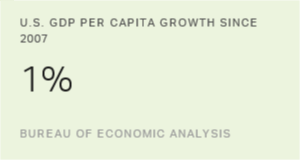Story Highlights
- August 2015 P2P even with August 2012 rate
- Underemployment ticks up to 14.5%
- Unemployment even with 6.3% measured in August 2014
WASHINGTON, D.C. -- The U.S. Payroll to Population employment rate (P2P), as measured by Gallup, was 45.3% in August. This is down two-tenths of a percentage point from July, but is even with the rate measured in August 2012, the highest Gallup has measured for any August since tracking began in 2010.

P2P rates typically begin leveling off or falling in August after having risen through the spring and summer. This year appears to be no different, though the monthly figures have been higher in 2015 than in the comparable months most previous years.
Gallup's P2P metric tracks the percentage of the U.S. adult population aged 18 and older who work for an employer for at least 30 hours per week. P2P is not seasonally adjusted. The latest results are based on Gallup Daily tracking interviews with 31,469 Americans, conducted Aug. 1-31 by landline telephone and cellphone. Gallup does not count adults who are self-employed, work fewer than 30 hours per week, are unemployed or are out of the workforce as payroll-employed in the P2P metric.
Overall, P2P is an important measure of the health of the economy; P2P tracks closely with other objective measures of economic productivity such as GDP per capita, as well as with subjective measures such as life evaluations and physical well-being.
Workforce Participation Steady at 66.9% in August
The percentage of U.S. adults participating in the workforce in August was 66.9%. This is even with the rate measured in July 2015 and in August of last year. Since January 2010, the workforce participation rate has remained in a narrow range, from a low of 65.8% to a high of 68.5%. But since mid-2013, it has most often remained below 67.0%. Workforce participation is defined as the percentage of adults aged 18 and older who are working, or who are not working but are actively looking for work and are available for employment.
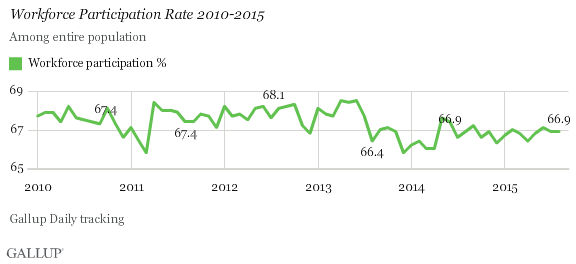
Unemployment Ticks Up to 6.3%
Gallup's unadjusted U.S. unemployment rate was 6.3% in August, up nominally from July's 6.1% and even with the rate measured in August 2014. After years of gradual decline, Gallup's unemployment measurement has not substantially changed from the rate measured a year ago, apart from a temporary seasonal spike in January. Gallup's U.S. unemployment rate represents the percentage of adults in the workforce who did not have any paid work in the past seven days, for an employer or themselves, and who were actively looking for and available to work.
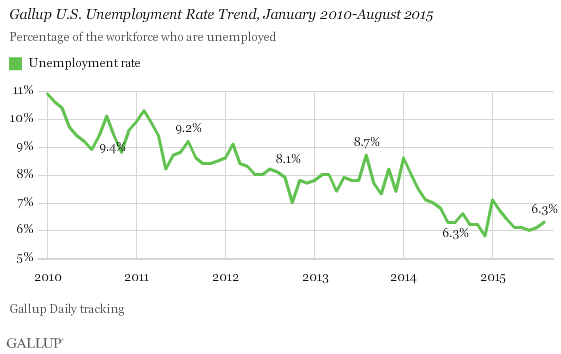
Unlike Gallup's P2P rate, which is a percentage of the total population, the unemployment rates that Gallup and the U.S. Bureau of Labor Statistics report are percentages within the labor force. While both Gallup and BLS data are based on surveys with very large sample sizes, the two have important methodological differences -- outlined at the end of this article. Additionally, the primary unemployment rate released by the BLS each month is seasonally adjusted, while Gallup reports unadjusted numbers. Though Gallup's employment numbers strongly correlate with BLS rates, the BLS and Gallup estimates of unemployment do not always track precisely on a monthly basis.
Underemployment Increases to 14.5%
Gallup's measure of underemployment in August is 14.5%, up 0.3 points from July. This rate is still lower than in any month other than July 2015 since Gallup began tracking it daily in 2010. Gallup's U.S. underemployment rate combines the percentage of adults in the workforce who are unemployed (6.3%) and those who are working part time but desire full-time work (8.2%).

Bottom Line
P2P ticked down as unemployment and involuntary part-time employment ticked up in August. However, these were not statistically significant changes, and moreover, they are broadly in line with what we would expect to see at this time of year: falling full-time employment and rising underemployment and unemployment. Overall, the employment situation continues to be moderately better than in recent years, but still much weaker than during the pre-2009 era.
The data in this article are available in Gallup Analytics.
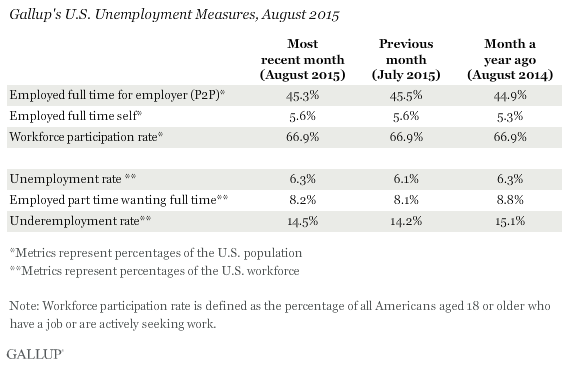
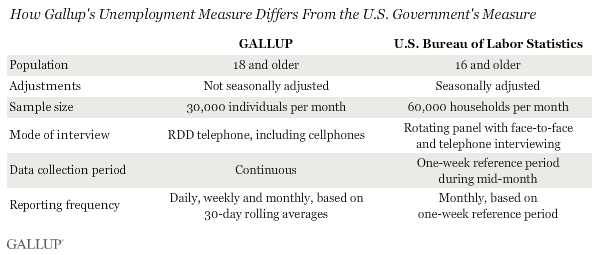
Gallup.com reports results from these indexes in daily, weekly and monthly averages and in Gallup.com stories. Complete trend data are always available to view and export in the following charts:
Daily: Employment, Economic Confidence and Job Creation, Consumer Spending
Weekly: Employment, Economic Confidence, Job Creation, Consumer Spending
Read more about Gallup's economic measures.
View our economic release schedule.
Survey Methods
Results for this Gallup poll are based on telephone interviews conducted Aug. 1-31, 2015, on the Gallup U.S. Daily survey, with a random sample of 31,469 adults, aged 18 and older, living in all 50 U.S. states and the District of Columbia. For results based on the total sample of national adults, the margin of sampling error is ±1 percentage point at the 95% confidence level. All reported margins of sampling error include computed design effects for weighting.
Each sample of national adults includes a minimum quota of 50% cellphone respondents and 50% landline respondents, with additional minimum quotas by time zone within region. Landline and cellular telephone numbers are selected using random-digit-dial methods.
Learn more about how the Gallup U.S. Daily works.
